We left Agra early for a full day of driving and a stop-over in Fatehpur Sikri. Fatehpur is just 40 km west of Agra and it was the capital of the Mughal Empire between 1571 and 1585. The capital was built here because the emperor at the time, Akbar, visited the city to consult with the famous saint Salim Chishti who predicted the birth of the heir to the throne. Akbar was incredibly tolerant of religions, so much so that he had Muslim, Christian and Hindu wives as well as cabinet ministers from the major faiths. The neat thing about his acceptance of the prevalent religions of the time is that you see the influence of each in the architecture. The structures here took just under 20 years to complete.

This is the building where government matters were discussed by the various ministers and the Emperor. You can see Islamic, Hindu and Christian architectural features in the central column. The walkway above is where the ministers and Emperor congregated for the meetings. The building is called the Diwan-i-Khas.


Emperor Akbar had a prized elephant that was used to carry out public executions. What you see below is a pretty strange monument that was erected in honour of that elephant when it died. The monument is a tower with stone elephant tusks protruding from all sides.

Below is the area of the palace dedicated to his three queens. As per the Islamic practice at the time, he was allowed to have as many wives as he pleased but he had to treat each equally. The queens were able to pick the size of their living quarters but the Emperor spent the exact same amount of money on each. For example the quarters of the Muslim queen are literally a medium sized room while the quarters of his Hindu queen are palatial. But as per the spending dictum, the quarters of the Muslim queen are far more intricate in their decoration and were covered in jewels while the decoration of the Hindu queen’s quarters were comparably Spartan.

This is the small structure that housed the Muslim queen. Note the intricate carvings on the red sandstone and try to imagine it decked out in jewels. This is called the Rumi Sultana:



To compare, those are the quarters of the Hindu queen:

Here is the bedroom of the Emperor. That huge structure that Kieran is hanging from, is his bed. At the time the floor was flooded in water that was decked out in rose petals to keep the room cool and fragrant.

The square depicted below houses a mosque and the shrine to the saint Shaikh Salim Christi, called the tomb of Islam Khan. The huge gate to the left is the victory gate, Buland Darwaza.

A frontal picture of the victory gate. The kid in the shot is Abdul who is trying to learn some additional languages so that he can be tour guide. His Spanish and English were pretty damn impressive.

This is the tomb of Islam Khan:

There were some musicians belting solid tunes out in front:

I managed to record them for a bit. They’re truly worth a listen:
This is a picture within the mosque. I’ve got to say that mosques are my favourite religious structures by far. You can kick off your shoes and just lay out in their lush carpets and rest as long as you want and no one harasses you. I’ve even napped in some mosques and it’s not considered at all disrespectful.

The following pictures are from the market area surrounding the mosque, near the victory gate.
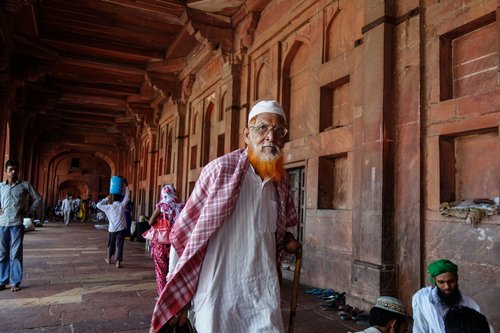




This is the area where you drop off and pick-up your shoes to enter the square housing the mosque. The little girl in the picture is Sandhya (meaning twilight in Hindi) who was also really nice. Her English was not quite as polished as Abdul’s but pretty impressive given that she’s self-taught.

After Fatehpur Sikri, we continued on to Jaipur.
As you can see below, our hotel was absolutely brilliant. It’s called the Hotel Bissau and it is in a 300 year old structure that used to be a private residence. This is exactly what I imagine India looks like through the eyes of Wes Anderson:





Something tells me that cool hotels are a thing in Jaipur. The place below is the Pearl Palace hotel where we went for dinner:


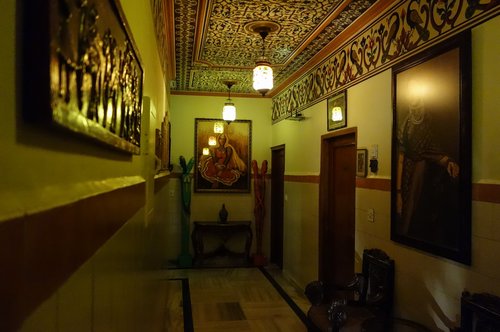

Kieran and Flo at the rooftop restaurant:

The following morning we headed off to see the sights. The pink structure below is the Palace of the Wind, completed in 1759. As impressive as it looks, it’s actually mostly an empty facade. No one actually lived there, rather it was built as an observation point for upper class ladies. They were not allowed to wander the streets so they used the building to observe the streets without being seen.


From there we went to the Amber Fortress, named after the surrounding Amber township. Across the lake, you can see the fortress, but I just took this picture because I continue to be fascinated by cows.

The fortress proper:

The whole township is enclosed within an 11 km long wall around the surrounding hillside. An interesting thing about this fort is that it is said to have a hidden treasury. Its location was kept secret, even from the King which I found fascinating. At the time, the King despite being all powerful was considered to just be a steward over the wealth of the city. As such, the King was only allowed to visit the treasury once during his reign and could only select one item to keep. There have been efforts to locate the treasure over the last 100 years, but only a fraction of it has been recovered.

Inside the fort:



Looking particularly handsome that morning:








Flo, Laura (our group leader) and Tim:



Flo taking a picture of Tim using the mirrored walls:

The lady in the picture below is one of the people who sweeps the grounds and lives off of tips both for sweeping and posing for pictures, though this picture is remarkably a candid shot. Photogenic lady:

More photos within the fort:


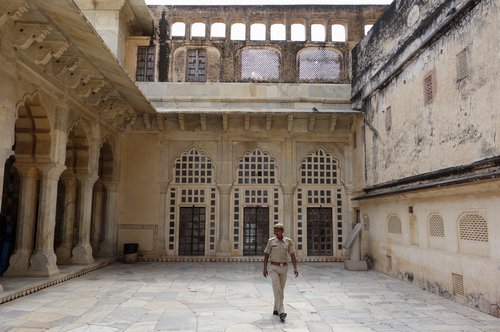
Ben posing suavely:

After visiting the fort we made a quick stop-over at the Lake Palace which was used as the royal residence in the summer months to take advantage of the cool breezes.

We then headed to an amazing garden featuring enormous equipment that was used for astronomy. The instruments look like works of art, and they are works of art in a sense, but they are also remarkably precise astronomical instruments.

Believe it or not, the huge structure below is a sundial, accurate within 20 seconds:

Even more impressive, the huge structure pictured below is yet another sundial, but accurate within 2 seconds:

Another instrument, not sure what it does but it looks good:
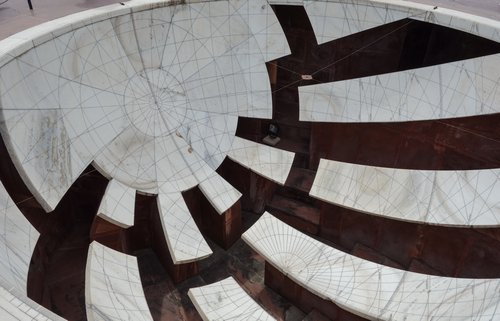
We went to a museum near the old city after the park full of instruments. We weren’t allowed to take pictures of the various textiles within, so I could only get a shot of one of the gates outside the museum.

Following the museum, four of us escaped down the road to a cool little restaurant called LMB for some lunch. This place is said to have some of the best food in the city but it was a tad expensive for the quality of the food. Still, it is worth visiting for the ambiance, and their dessert shop at the front has an amazing selection of stuff.

After lunch, I decided to take a brief walk around the market area and then head off on my own back to the hotel. I approached a number of tuk tuk drivers to take me back but they didn’t know where my hotel was. I then found a fellow who claimed that he knew where it was, and here’s the key to this story, we settled on a price.
Anyways, as we were on the way, it became pretty clear that the had no idea where the hotel was because he kept stopping to ask other drivers for directions. It was raining hard so I was getting soaked in the back even though there was a canopy over the tuk tuk. As such, I eventually got impatient and started yelling at him for lying about knowing where the hotel was, and I directed him to take me to another hotel where I knew that there were tuk tuk drivers that knew where they were going. At which point, he drove directly to my hotel as if he always knew exactly where it was. Given that we pre-arranged the price, I have absolutely no clue why he would pretend not to know where he was going.
For the evening, Tim and Laura arranged for us to watch a Bollywood movie in a proper Indian theatre. We had a quick dinner before at a nearby place:

This is the amazing theatre. I’ve never been to a theatre that was this pimped out:



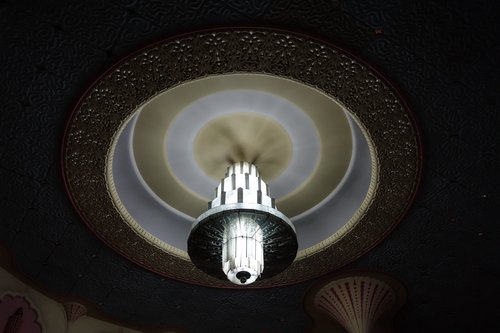
Watching a Bollywood movie in India is an amazing experience. For starters, the locals were taking just as many photos of the theatre as I was. Then, once the movie started, no one was shy about talking, texting and openly jeering at the screen or ooooing when a character was doing something particularly steamy on scene–though that is a relative thing in India. The movie was over two hours long and was a love story, but the main characters (who get married by the end of the movie) never even kiss. Not even after they get married.
It was also quite amusing that they still do intermissions and that the second the credits start rolling, they turn on the lights even if things are still going on in the movie. So who knows, maybe they did kiss at the end of the wedding scene?
I leave you with a panoramic shot of the movie screen with its red velvet curtain:


Veo que este día fue de un recorrido bastante atractivo, parece un cuento de las Mil y Una Noche. Que buenas tomas hiciste de todos los edificios y sus interiores. Veo que taxistas sinvergüenzas hay en todo el mundo y lo malo es que estas en sus manos y te pueden meter en un grave problema que te arruine tu día o tu viaje. Esta experiencia te habrá confirmado que no debes andar solo en lugares extraños.
Se que en la India hay películas de muchas horas, creo que la que vista estaba muy corta y ademas con censura.
Me imagino que por esos lugares pasaste tu cumpleaños.
Que sigas disfrutando tu viaje.
Un abrazo. Felicidades.
LikeLike
Love the lady in yellow and the adorable children.
LikeLike
Beautiful pictures Andres. Mosques are my favorite religious structures too. The iconography is so mathematical–which seems a far more accurate representations of creation than the anthropomorphic images in other religions.
Everything looks amazing so far. Keep posting beautiful images!
LikeLike
Thanks, I’ll try not to fall behind too much and keep posting!
LikeLike